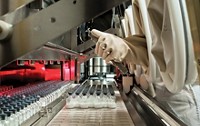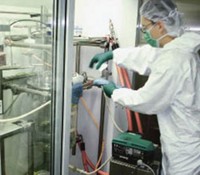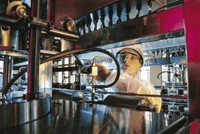Advertisement
Grab your lab coat. Let's get started
Welcome!
Welcome!
Create an account below to get 6 C&EN articles per month, receive newsletters and more - all free.
It seems this is your first time logging in online. Please enter the following information to continue.
As an ACS member you automatically get access to this site. All we need is few more details to create your reading experience.
Not you? Sign in with a different account.
Not you? Sign in with a different account.
ERROR 1
ERROR 1
ERROR 2
ERROR 2
ERROR 2
ERROR 2
ERROR 2
Password and Confirm password must match.
If you have an ACS member number, please enter it here so we can link this account to your membership. (optional)
ERROR 2
ACS values your privacy. By submitting your information, you are gaining access to C&EN and subscribing to our weekly newsletter. We use the information you provide to make your reading experience better, and we will never sell your data to third party members.
Business
Custom Chemicals
Slowly recovering in 2010, contract manufacturers envision a path toward growth by responding to marketplace shifts
by Ann M. Thayer
January 31, 2011
| A version of this story appeared in
Volume 89, Issue 5

As was the case last year, 2011 looks to be a year of transition for pharmaceutical chemical suppliers. The recession spooked everyone, causing business to slow and projects to fade away. Contract manufacturers worked hard just to retain customers and keep their operations running. A modest recovery gradually materialized in 2010, and it is expected to continue.
Ghosts of the recession linger, however. Large pharmaceutical companies are still integrating acquisitions, reprioritizing R&D, and testing the waters in new areas such as generic and biologic drugs. Meanwhile, with some funding appearing, emerging drug companies are slowly restarting development projects. As customers work through their changes, custom chemical providers are trying to respond.
When resources were limited, companies advanced their less risky, late-stage candidates while cutting back on drug discovery and early-stage development. Although firms that were successful in doing that have brought forward backup or follow-on molecules, “the general focus remains on putting money to work on late-phase assets,” says Brian O’Neill, North American sales manager for Carbogen Amcis.
The lack of discovery and early-stage work is “going to lead to an empty cupboard for quite a few years,” points out Kenton Shultis, chief executive officer of the Syracuse, N.Y.-based consulting firm Rondaxe. He sees a bright spot, however, in the quality of projects that drug companies are choosing to fill the gap. “There’s a tendency now to be more careful about what to work on,” he says.
Although business is improving, it hasn’t regained its prerecession vigor, executives say. Ampac Fine Chemicals’ (AFC’s) recent report on the fiscal year ending Sept. 30, 2010, revealed a 27% revenue decline. Delayed orders, plant downtime, and the need to address regulatory issues were among the factors contributing to low production volumes and lost sales, explains Aslam Malik, AFC’s president.
On the plus side, AFC’s revenues from drug development projects increased 130%. Having strengthened R&D efforts a few years ago, “our pipeline is looking really good,” Malik says. The company expects at least a 25% increase in sales in fiscal 2011 from new contracts, repeat business, and restarted orders. It will also continue to prepare its plant in La Porte, Texas, acquired in mid-2010, for new production using its capabilities in energetic and other hard-to-handle chemistries.
Seeing more inquiries from innovator firms and a backlog in generics, Cambrex CEO Steven M. Klosk is cautiously optimistic that changes are finally for the better. For 2010, Cambrex’ sales are expected to be down 3 to 5%, but 2011 looks more promising. “We have 12 Phase III projects with customers on the innovator side, and we are always looking to increase that,” he says.
For the industry overall, Klosk adds, “I don’t see business booming, and quite frankly, there needs to be some consolidation.”
Despite past hard economic times, the number of suppliers vying for business hasn’t really declined. “There are bits and pieces shifting left, right, and center in ownership, but the leading fine chemicals companies still only have very small market shares,” explains industry consultant Jan Ramakers. “The industry isn’t any more concentrated than it was a year ago, two years ago, or 10 years ago.”
Production capacity has been moving into the merchant market as big pharma companies sell plants. Although this trend may mean more outsourcing of products that were once made in-house, it does nothing to improve capacity utilization. Aside from this approach, big pharma has been buying less material less often to limit costs in the development pipeline, explains Mark Cassidy, contract manufacturing services vice president at SAFC, the fine chemicals arm of Sigma-Aldrich.
“The supply side has not decreased in line with the demand,” Cassidy says. And even faced with overcapacity, many suppliers hang on to undifferentiated facilities of widely varying quality, he adds. The general small-molecule active pharmaceutical ingredient (API) side of the industry faces thinner pipelines, slower decision making, and lower margins.
The result is that companies claiming to have fared well in 2010 typically saw growth in the low single digits and didn’t necessarily make much of a profit. “If you look at the operating profits of the top 40 fine chemicals companies, profitability levels dropped at the end of 2009 and the first half of 2010,” Ramakers says. “They have been bouncing back—maybe not to the levels of before, but profitability levels certainly are on the rise again.”
One challenge has been maintaining profits in the face of price demands from customers. “With the scarcity of capital, a number of the emerging companies are trying to do more with less money,” Carbogen’s O’Neill says. “There is still some pricing pressure from reputable suppliers in the Far East that will continue in the current environment.” For Switzerland-based Carbogen, leveraging the assets of its Indian parent Dishman has been one way to reduce costs.
AFC has been “countering that pressure through process improvements,” Malik says. “You can reduce the price, while still being able to make a margin.” Technical accomplishments aside, he acknowledges that when production moves faster, the pressure grows to scale up new processes and find more products quickly to keep a plant operating at full capacity.
Although cutthroat pricing is always an issue in the generic API business, many suppliers are bullish on the sector and forecast double-digit growth. Along with an increase in demand, product quality problems in Asia have helped Western suppliers. In 2009, generic products accounted for 42.3% of revenues in the $91 billion global API market, according to India’s GBI Research. By 2015, generics are expected to reach 48.5% of sales.
“Interest in manufacturing generic APIs has dramatically increased,” Shultis says. As patents expire, some big pharma companies are trying to compete in the generics market by making their own compounds or sourcing from others. “They tried this before, years ago, and maybe it will be different this time if there is a better understanding of what a reasonable margin is in this industry,” he says. “They want to get a return on their capital investments now and I think are looking at it in a more reasonable way than they did in the past.”
Last year, Rondaxe, in connection with patent and scientific information provider Thomson Reuters, launched a service that allows companies to develop API manufacturing cost estimates. “Generics are extremely cost-of-goods sensitive, and we can generate a reasonable process and good estimate of what it will cost,” Shultis explains. The approach can, for example, help in evaluating suppliers or in choosing routes and products to pursue.
Cambrex’ Profarmaco generics unit faced such decisions in committing to the 15 new APIs now in its pipeline. “There is a growing trend of more generic prescriptions, and it’s all a matter of introducing new products” while controlling costs and increasing efficiency, Klosk says. On the demand side, he adds, “everyone cut back on their supply chain as much as they could, so there is now some restocking and replenishing going on.”
Custom chemical firms are responding to the pharma market’s mounting enthusiasm for biopharmaceuticals, including generic products referred to as biosimilars. “More and more biopharmaceuticals will go off patent in the coming years, and the opportunities for biosimilars are going to be increasing,” Ramakers says. “Leading fine chemicals companies have been or are starting to be active in the biotech field and are building up their capacity and capability for all good reasons.”
According to GBI Research, biotech-derived APIs accounted for just 17% of the 2009 API market in terms of sales but should expand to nearly 24% by 2015. Double-digit growth in the biotech and generic arenas will help the overall API market grow by about 6% per year to 2015, GBI reports.
Lonza is among the many custom manufacturers that have expanded capacity outside the small-molecule arena. In 2010, it added protein development services and joined with California Peptide Research to offer peptide scale-up services to CPR’s customers. Lonza signed a deal with GlaxoSmithKline to support its biopharmaceutical pipeline and inked manufacturing contracts with smaller and emerging companies.
“The addition of new technologies and services has already received high marks from emerging and established players alike,” says Stephan Kutzer, president of Lonza America. Lonza’s biological development project and manufacturing pipeline increased substantially during 2010, and its capacity utilization went up as well.
On the small-molecule side, Lonza boosted its pipeline of preclinical and development-stage projects, but capacity utilization has yet to return to prerecession highs. A new alliance with Dalton Pharma Services is designed to transition projects from that company to Lonza for clinical- and commercial-scale manufacturing. “The streamlining and operational-excellence activities that were started in 2009 are all nearly complete,” Kutzer says.
Both Lonza and SAFC expanded into the biologics niche of viral vaccines and therapeutics. Last summer, Lonza acquired Houston-based Vivante GMP Solutions. Vivante, the former manufacturing unit of Introgen Therapeutics, became a privately held contract manufacturing firm in 2009. It now operates as Lonza Viral-Based Therapeutics.
Meanwhile, in late 2009, SAFC opened new viral manufacturing suites for large-scale production in Carlsbad, Calif. Being able to serve preclinical through commercial needs, SAFC saw strong growth in the viral vaccines and gene therapeutics areas in 2010, Cassidy says. “An important feature of that growth is that it is in later-clinical-phase opportunities.”
Late last year, SAFC completed an expansion at its Jerusalem fermentation facility for making proteins and APIs, including secondary metabolites and cytotoxins. The expansion feeds its business in both biologics and highly potent compounds. Earlier in the year, SAFC opened a $30 million commercial-scale facility in Verona, Wis., that added to existing high-potency capabilities in nearby Madison.
“In 2010, SAFC’s overall portfolio showed strong year-on-year growth,” Cassidy says. Although the general small-molecule API area has been challenging, SAFC’s high-potency and bioscience businesses performed well. “That was particularly satisfying to see because it endorses our strategy for growing in the pharma area with these differentiated offerings and serving some of the more challenging and newer needs of our customers,” he adds.

The market for highly potent APIs is growing well above the average rate for the custom chemical industry, Ramakers says, because numerous high-potency compounds, notably oncology drugs, are in development. “About 10 to 12% of the market currently is high potency, as is about one-quarter or more of the development pipeline,” he estimates.
Several firms are betting on this area. In 2008, Cambrex added a center for high-potency drug development in Charles City, Iowa. Ash Stevens has been expanding in the Detroit area. Meanwhile, Lonza, SAFC, and others are combining high-potency API and biologics handling capabilities in the production of antibody-drug conjugates.
Early in 2010, Carbogen Amcis opened a high-potency API facility in Ahmedabad, India. “We are in the process of transferring projects over there,” O’Neill says. The new site offers larger-scale production than the company has in Switzerland and can serve as a secondary supply source.
In acknowledgement of the tepid economic climate, the company has been trying to invest wisely in capital equipment, O’Neill explains. “Most of our emphasis has been on adding capabilities and a bit of debottlenecking in the high-potency area.” Some money has gone into wet milling, a means by which API particle size can be reduced while cutting the potential exposure of plant operators to fine powders.
AFC also handles potent and cytotoxic compounds and has invested in milling in the U.S. Having that capability reduces complexity for customers, Malik says, because AFC can mill the APIs it synthesizes, rather than having to send them to a third party. “This new capability has been outstanding for us, and we have already done quite a few products this year,” he notes.
In 2010, AFC also signed on to a partnership that allows it to evaluate biocatalysts from Codexis. Through the arrangement, it can combine biocatalysis with other methods—such as simulated-moving-bed chromatography—that it uses to make chiral molecules. “Having all those technologies in our arsenal can help us solve a lot of customer problems faster,” Malik says.
Advertisement
Codexis has signed similar deals with DSM and Dishman. DSM, for example, will add Codexis biocatalysts to its own in its InnoSyn route-scouting service. “The enzyme very often is a good part of the process, but not the cost driver, so combining it with other pieces of technology can be more competitive,” says Peter Seufer-Wasserthal, senior vice president of Codexis Pharmaceuticals.
“If you just compare the raw-material costs of chemocatalytic and biocatalytic routes, they may be comparable,” he says. “But if you then add in capital expenditures, such as waste treatment, you can get real economic benefits from biocatalysis.”
Codexis also partners with other companies, including India’s Arch Pharmalabs, that manufacture intermediates and APIs. Working with other fine chemicals firms is a relatively new strategy for Codexis, Seufer-Wasserthal admits. “We realized that we cannot supply all the intermediates of this world, so by enabling other companies we have a bigger chance of getting a larger piece of the pie.”
In 2010, Codexis entered a new phase, becoming a publicly traded firm and experiencing a shift in business. Once based primarily on research funding and small-scale enzyme sales, it now sells commercial quantities of enzymes and intermediates.
“We now are supplying a good number of intermediates and Phase II drugs,” Seufer-Wasserthal says. Product sales accounted for about one-third of revenues at Codexis in 2010, up from one-quarter the year before. Codexis reports that about 15 drug companies are using its enzyme panels or kits to find leads in process development for both new and generic drugs. “We always used to have a generic pipeline, but now the innovator pipeline is catching up,” he adds.
To expand in the biocatalysis area, Cambrex bought the German enzyme company IEP in 2010. The business was already involved in some commercial-scale projects, and Klosk hopes to see more emerge. “IEP opens a lot of doors on the technology side, while we have a lot of customer relationships and can expose many more customers to that technology,” he says.
Many custom chemical companies are building their businesses on specialized and niche technologies. Hovione CEO Guy Villax explains that his firm is building four distinct businesses: API production, particle design, inhalation drug delivery, and generic compounds. Taken together, the company expects about 7% sales growth for the fiscal year ending in March.
Beyond diversification, the businesses also bring unique synergies for Hovione. The 2010 launch of an influenza drug in Japan by Daiichi Sankyo was made possible by the development of Hovione’s TwinCaps inhaler device. “No one else does all the components. We can make the API, we have expertise in particle design, we develop the formulations, and we have our own devices,” Villax says. “We have worked quite hard to ensure customers get absolutely everything from us.”
Meeting the expanding needs of customers—be it alone or by working with partners—is a challenge that custom chemical firms face. As customers try to reduce costs and boost the globalization of sourcing, an increased need for visibility and transparency in the supply chain is becoming more apparent, SAFC’s Cassidy explains. “It’s a structural issue that is only going to increase as we go forward.”
The task, he says, becomes “managing quality within the context of complex global supply chains and also being able to do that with a very broad range of products and services to support the development of small and large molecules.”





Join the conversation
Contact the reporter
Submit a Letter to the Editor for publication
Engage with us on Twitter